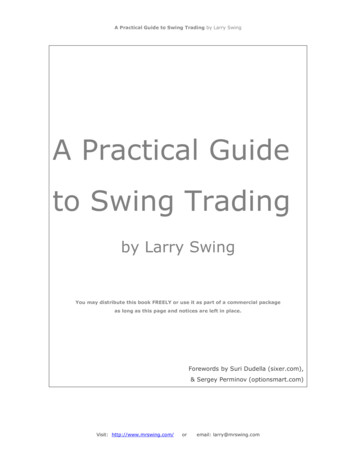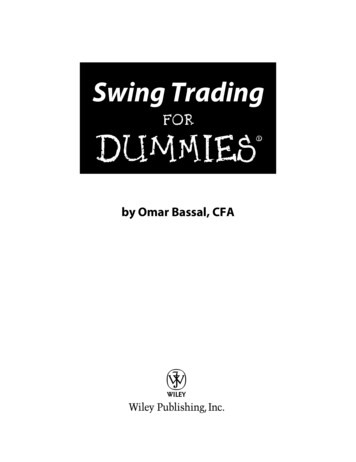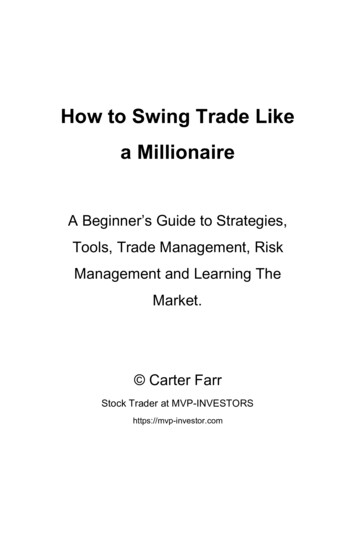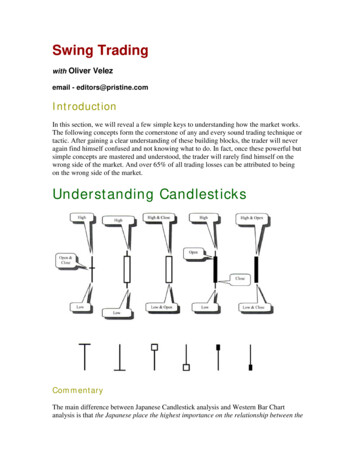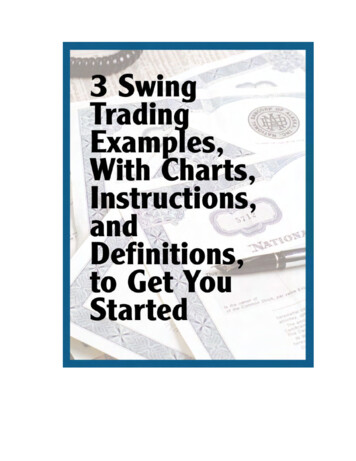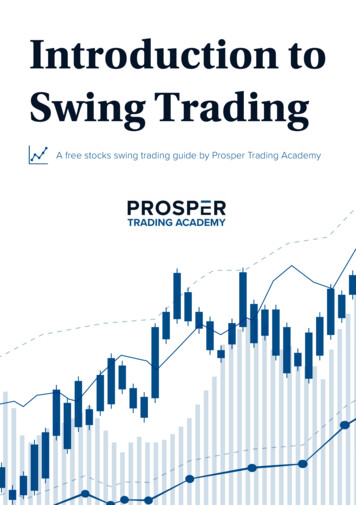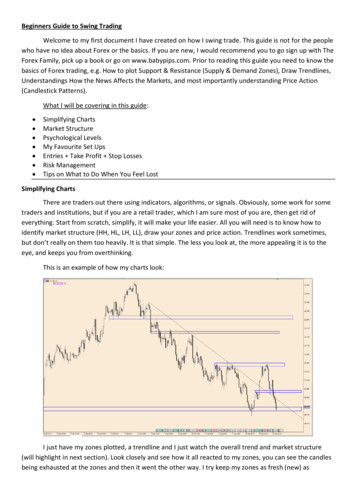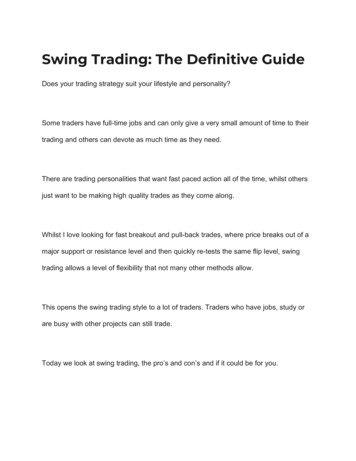
Transcription
Swing tradinghow to achieve the best income from your investinginthe short term and profit from market fluctuations;howto deal with losses and wisely manage your revenues:options and stockBy Andrew Anderson
TableofContentChapter OneWhat Is Swing TradingChapter TwoIs Swing Trading Right For MeChapter ThreeHow To Swing TradeGenuine Example of Swing Trade in AppleChapter FourWaves And TrendsTrends Secular Trend: Primary Trend: Secondary Trend:WavesTypes of Elliot Wave Patterns Impulse wave: Diagonal wave:Chapter FiveStagesStage OneStage TwoStage ThreeStage FourChapter SixUps And DownsUptrendsDowntrendsChapter SevenChoosing Your Market
Watch The CalendarBe Careful of Penny StocksBe Careful of Falling StocksChapter EightTools For Swing TradingTurn Up the VolumeTune Into AroonFibonacci RetracementChapter NineEntry StrategyConsecutive price patternsThe Aggressive EntryWhy identifying swing are points important?Chapter TenExit Strategy1. Setting Your Initial Stop Loss Request2. Profit Taking Strategies Selling At ResistanceChapter ElevenTrading Pullbacks And RalliesPurchasing Pullbacks And Shorting RalliesThe Main PullbackFirst Pullback After A BreakoutThe Key To Trading Rallies And PullbacksChapter TwelveBest Indicator For Swing TradingMoving AveragesMACD (Moving Average Convergence Divergence)RSI (Relative Strength Index)On-Balance Volume (OBV)Chapter Thirteen
Problems With Swing Trading Using Options1. Strike Price2. Expiration Date3. Extrinsic Value4. Bid-Ask SpreadChapter FourteenBuild A Swing Trading SystemChapter FifteenSwing Trading StyleChapter SixteenSwing Trading PsychologyGetting A Grip On EmotionsFearGreedChapter SeventeenTechnical Analysis And Swing TradingOscillatorCandlestickOscillator DivergenceBullish and Bearish Engulfing PatternsHesitation CandlesChapter EighteenVital Guidelines Rules:Best practices:Options:Chapter NineteenTop Tips For Swing TradersChapter TwentyForex Swing StrategiesForex Trading Strategy Types
Forex volatility strategies Forex trend following strategies Forex scalping strategies Forex pivot point strategies Forex chart pattern strategies Forex Renko chart strategiesPicking The Best Forex Trading StrategyChapter Twenty OneEliminate EmotionsChapter Twenty TwoTrend Following TradingChapter Twenty ThreeTrading Stocks With Swing TradingFive Swing Trading Strategies For Stocks1. Fibonacci Retracement2. Support And Resistance Triggers3. Channel Trading4. 10-and 20-day SMA5. MACD CrossoverChapter Twenty FourShort Swing Trading With ETF'SChapter Twenty FiveDynamic And Static Risk ManagementChapter Twenty SixSuccess StoriesKyle DennisPetra HessChapter Twenty SevenRisk Management
What is Risk Management?The Good, the Bad, and the NecessaryHow Investors Measure RiskRisk and PsychologyPassive vs Active RiskImpact of Other FactorsThe Cost of RiskChapter Twenty EightTrading Congestion EntranceChapter Twenty Nine2 Forms of AnalysisTechnical Analysis1. The Market Discounts Everything.2. Price Moves In Trends.3. History Tends To Repeat Itself.Limitations of Technical AnalysisFundamental AnalysisLimitations of Fundamental AnalysisChapter ThirtyCan You Get RichSwing Trading As a Major Source of IncomeSwing Trading As a Part-Time Source of IncomeChapter Thirty OneYou Can't Win All TradesChapter Thirty TwoSetting Up Your AccountUnderstanding the Different Types of Brokers Discount brokers: Direct access firms:
Looking For Broker ProspectsEvaluating a Potential Broker Commission rate: Trading other asset classes: Banking services: Customer service: Opening An AccountChapter Thirty ThreeDaily Life Of A Swing TraderPre-MarketMarket OverviewFind Potential Trades Unique opportunities: The sector plays:Make a Watch ListCheck Existing PositionsMarket HoursAfter-Hours Market
Chapter OneWhat Is Swing TradingSwing trading is the demonstration of profiting from protections that havetransient value developments between a couples of days, to half a monthlong. Once in for a little while, this can hit a month or two most extreme, yettypically it's inside a period of a couple of days. Swing traders are people andsome of the time organizations like multifaceted investments. They usuallydon't have positions 100% of the time; instead, they trust that the correctopen doors will bounce in. They will likely exploit a sign up or down patternin evaluating. At the point when the stock market is picking up andprogressing nicely, they purchase all the more then they sell. At the pointwhen the market is powerless, they are short increasingly then they arebuying. In the end, when the market isn't excelling by any stretch of theimagination, they sit as an afterthought and hang tight for another chance.Are far as taxes go with Swing Trading, there are a couple of essentialthings to know. How much tax you pay on your profit relies upon a couple ofdifferent components. First is to what extent you are holding your positions.If you own a position 366 days, only one day over a year, at that point you sellit, you will make good on a lower regulatory expense rate than typical on yourprofit. This income rate is more often than not at about 15% for a great manypeople, yet can be as low as 5% for individuals with lower income. The presenttax law that sets the 15% tax rate is set to lapse toward the finish of 2010, soit could change after that date.Swing traders will, for the most part, not qualify for this rate as they don'tclutch positions for extremely long. Transient profits are generally taxed at apeople ordinary taxation rate. There are exceptional cases to this standard. Ifyou are classified as an example informal investor and you exchange at leastfour round-trip day exchanges every five business days, at that point you canregard your profits and losses as an expense of working together. Youadditionally need to keep up a record with 25,000 or more in it. This can beexceptionally valuable as you can classify capital gains and losses as typicalincome and loss. If you are doing high volumes of trading, you can set aside a
great deal of cash along these lines. This isn't for everybody, as you must havea decent measure of money to exchange with.There difference between a swing trader and a purchase and holdfinancial specialist is that the buy and keep speculators couldn't care lessabout value swings. They are just intrigued by the long haul development oftheir cash, so they expect that their positions will go up in cost over a moredrawn out measure of time. Generally, this is quite a long while not far off, sothey are not taking a gander at everyday value swings, only the master plan.Purchase and hold contributing isn't exceptionally time escalated and canbring a ton of profit if you do not need cash flow.Swing trading isn't for everybody, except for somebody that has a ton ofpoise and a decent hard working attitude, there is a great deal of profit to bemade. Being instructed, experienced and committed is an enormous piece ofbeing a fruitful swing trader.Swing trading is different from buy-and-hold trading and day trading. Thedifference will be listed below for more clarity.Opposite the buy-and-hold investor on the trading continuum is the daytrader. Day traders don't hold any positions overnight. Doing as such wouldexpose them to the risk of a hole up or down in a security's price that couldcrash a considerable part of their account. Instead, they monitor pricemovements on a minute-by-minute basis and time entries and exits that spanhours.Day traders have the advantage of riding security price movements that canbe quite volatile. This requires time-intensive devotion on their part. Nearterm price movements can be driven by a noteworthy seller or buyer in themarket and not by a company's fundamentals. Henceforth, day tradersconcern themselves with investor psychology more than they do withfundamental data.
They're tracking the noise of the market — they want to know whether thesound is getting more intense or quieter. But it's not all cake and tea for daytraders. They trade so often they rack up significant commission charges,which makes it substantially more challenging to beat the general market. A 5,000 profit generated from hundreds of trades may net a day trader asignificantly decreased amount after commissions and taxes are taken out.This does exclude additional costs the day trader must sustain to support hisor her activities.Swing traders also face stiff commissions (versus the buy-and-hold investor),but nothing as severe as the day trader. Because price movements’ spanseveral days to several weeks, a company's fundamentals can become anintegral factor to a more significant degree than they accomplish for the daytrader (day-to-day movements are expected less to fundamentals and moreto short-term supply and demand of shares). Also, the swing trader cangenerate higher potential profits on single trades because the holding timeframe is longer than the day trader's holding that is all.
Chapter Two Is Swing Trading Right For MeSwing trading means trading stocks commodities, or forex when the traderholds the stock for around four days to seven days. Here the trader buys andundercuts in the period. Intraday trader exchanges between the markethours. It very well may be even an exchange between 5 minutes. In swingtrading, you purchase at a relatively low and undercut within a range.A swing trader designs his move between the time of little time lows andhighs. He sees slight wretchedness and purchases his stock and trusts that thedownturn will see daylight, and undercuts in this time and gains profit. Aswing trader must be a sharp market eyewitness, to comprehend the statesof mind and the swings of this odd spot. He needs to utilize various techniquescontemplate their inclination to ebb and high and analyze the likelihood toexchange during these tides.The fundamental prerequisite for a swing exchange is a stock ought to have anature to incline. If you have been a stock market member even once you willsee a couple of stocks scarcely change positions and stay stable with barelyany variances. Numerous multiple times, by the day's end of trading, there ispositively no adjustment in their qualities as well. If they are sliding worth,they rise gradually, and if they grow, it's not a difference. In this way, theseare ventures that don't give any profit to the trader in any event for theindividuals who go for objectives in brief length.A few stocks show sporadic highs and lows. The graph is going on anddynamic. So if you see a fall in value you are guaranteed, it's for the occasion,and it will undoubtedly climb once more. In this manner, these stocks giveyou various chances to take a low position and furthermore gain profit at high.Swing traders exchange this kind of profiting stocks.One needs to comprehend stock market trading is a game with odds of lossequivalent to odds of profit. One needs to be astute to plan out when to enterand when to leave the market. Entering the market means taking positionsand purchasing a stock. Going means stopping or selling your stock.
Numerous individuals go when the market sinks as each time the graph falls,you see your cash disappearing and acquiring loss. In this way, the frenzy ispure.To anticipate this, a savvy trader takes a cutoff position. He has his homeworkdone earlier and knows when he should leave and how much loss he canmanage. So he cuts off guidance at a worth. At the point when the stock worthachieves this level, you consequently leave the market. At that point, you cantake a position at a then low, and trust that the market will go up andovercome this loss.Various traders gain a constrained profit in an improving market. They exitnotwithstanding when the market is as yet rising. This is because they havedetermined the dangers included, and since you can never foresee nextminute, they want to restrain their profit as much as they limit their loss.
Chapter ThreeHow To Swing TradeA swing trader tends to search for multi-day chart patterns. A portion of themore typical patterns includes moving normal crossovers, cup-and-handlepatterns, head and shoulders patterns, banners, and triangles. Key inversioncandlesticks might be utilized in addition to other indicators to devise a robusttrading plan.Ultimately, each swing trader devises an arrangement and strategy that givesthem an edge over numerous trades. This includes searching for trade setupsthat tend to prompt predictable movements in the asset's cost. This isn'tsimple, and no strategy or structure works without fail. With an idealrisk/compensate, winning each time isn't required. The higher therisk/reward of a trading strategy, the fewer times it needs to win to create anoverall profit over numerous trades.The Steps in Swing TradingFirst, restrict your selection to the universe of stocks that fulfil specific criteria.Choose stocks that:Have a price of at least 7Have an average daily volume of at least 500,000 sharesThen,STEP 1 – Identify a stock that is in an uptrend or a downtrend.STEP 2 – For stocks in an uptrend, identify those that are experiencing apullback.For stocks in a downtrend, identify those that are experiencing a pull-up. STEP3 – Once an appropriate candidate is identified, place a limit order to buy(Uptrend) or sell short (downtrend) the stock based on the Master Plan. STEP4 – Once a stock has been traded (a position opened), place a stop-loss orderto limit downside risk and set a limit order to identify the price at which youwill take profits. (Ideally, these two orders are placed together as an OCO
(One Cancels Other) order; this is sometimes called an OCA (One Cancels All)order.STEP 5 – At the end of each day, adjust the stop loss prices based on theMaster Plan.Genuine Example of Swing Trade in AppleThe chart above demonstrates a period where Apple (AAPL) had a substantialvalue move higher. A little cup trailed this and handled pattern, which oftenflags a continuation of t
Trend Following Trading Chapter Twenty Three Trading Stocks With Swing Trading Five Swing Trading Strategies For Stocks 1. Fibonacci Retracement 2. Support And Resistance Triggers 3. Channel Trading 4. 10-and 20-day SMA 5. MACD Crossover Chapter Twenty Four Short Swing Trading With ETF'S Chapter Twenty Five Dynamic And Static Risk Management
